Create DNS records at Google Domains for Office 365
If Google Domains is your DNS hosting provider, follow the steps in this article to verify your domain and set up DNS records for email, Lync, and so on.
These are the main records to add. (Need more help? Get support.)
After you add these records at Google Domains, your domain will be set up to work with Office 365 services.
To learn about webhosting and DNS for websites with Office 365, see Use a public website with Office 365.
Note: Typically it takes about 15 minutes for DNS changes to take effect. However, it can occasionally take longer for a change you've made to update across the Internet's DNS system. If you're having trouble with mail flow or other issues after adding DNS records, see Troubleshoot issues after changing your domain name or DNS records.
Add a TXT record for verification
Before you use your domain with Office 365, we have to make sure that you own it. Your ability to log in to your account at your domain registrar and create the DNS record proves to Office 365 that you own the domain.
Note: This record is used only to verify that you own your domain; it doesn't affect anything else. You can delete it later, if you like.
-
To get started, go to your domains page at Google Domains by using this link. You'll be prompted to sign in. To do so:
First, choose Sign In.
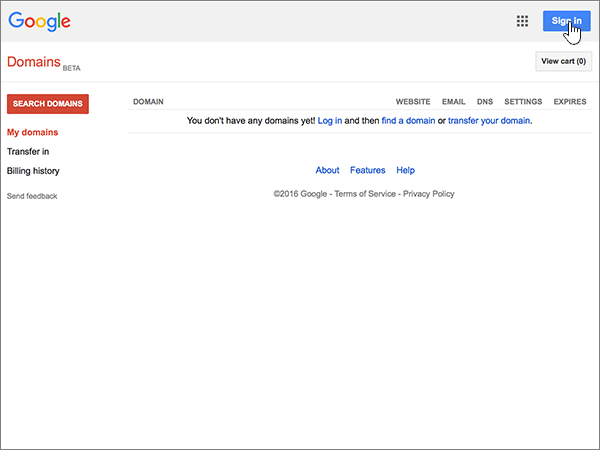
Next, enter your login credentials, and then again choose Sign In.
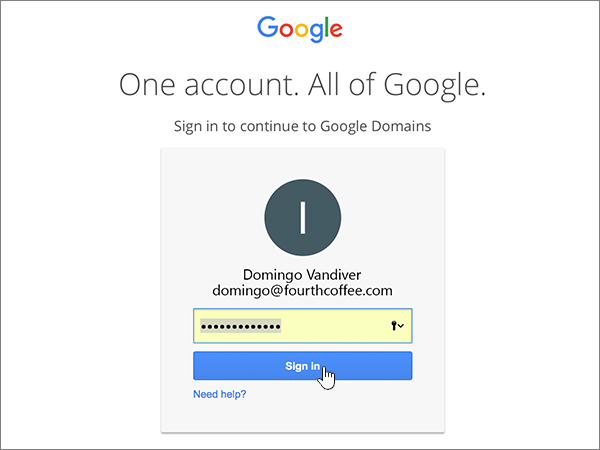
-
On the Domains page, in the Domain section, choose Configure DNS for the domain that you want to edit.
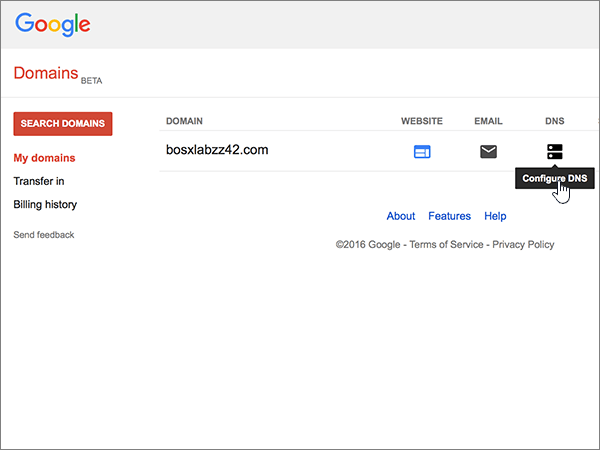
-
In the Custom resource records section, in the boxes for the new record, type or copy and paste the values from the following table.
(You may have to scroll down.)
(Choose the Type value from the drop-down list.)
Name
Type
TTL
Data
@
TXT
1H
MS=msXXXXXXXX
Note: This is an example. Use your specific Destination or Points to Address value here, from the table in Office 365.
How do I find this?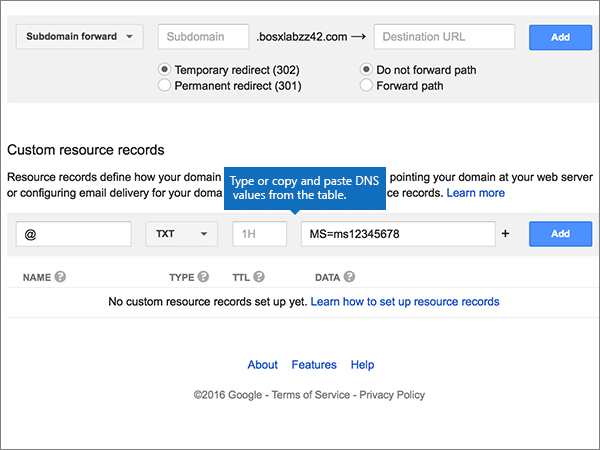
-
Choose Add.
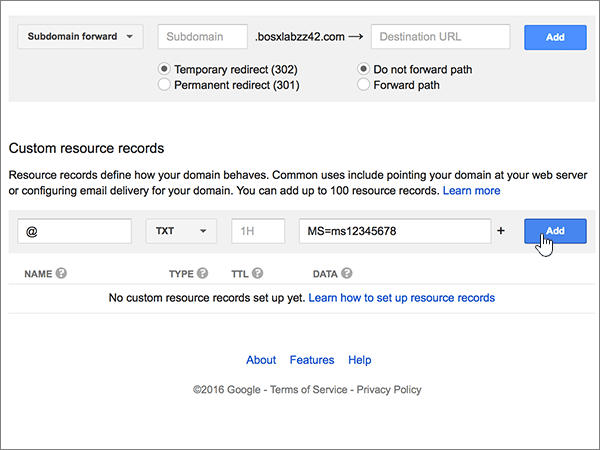
-
Wait a few minutes before you continue, so that the record you just created can update across the Internet.
Now that you've added the record at your domain registrar's site, you'll go back to Office 365 and request Office 365 to look for the record.
When Office 365 finds the correct TXT record, your domain is verified.
-
On the Manage domains page, select the domain that you are verifying and then, in the Action column for that domain, choose Start setup.
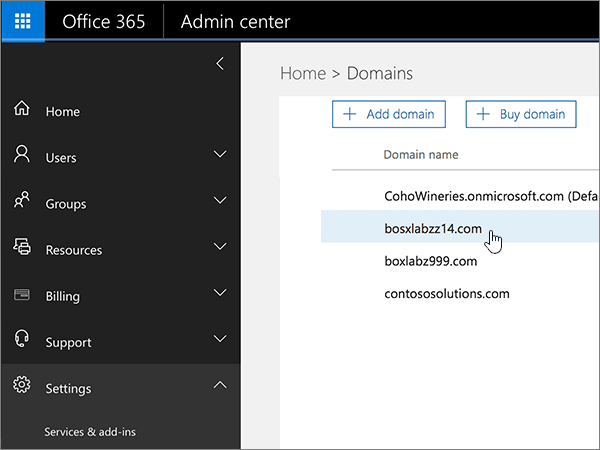
-
On the Add this TXT record to show you own domain_name page, choose Okay, I've added the record.
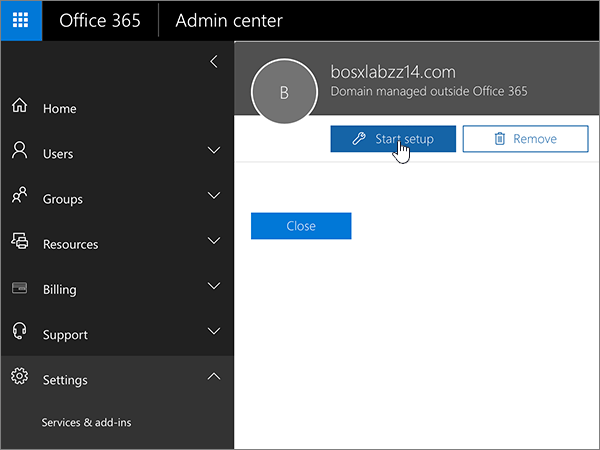
-
Choose Next.
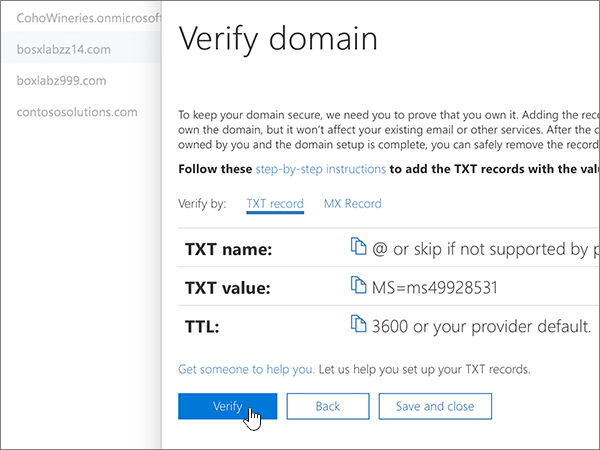
Note: Typically it takes about 15 minutes for DNS changes to take effect. However, it can occasionally take longer for a change you've made to update across the Internet's DNS system. If you're having trouble with mail flow or other issues after adding DNS records, see Troubleshoot issues after changing your domain name or DNS records.
Add an MX record so email for your domain will come to Office 365
-
To get started, go to your domains page at Google Domains by using this link. You'll be prompted to sign in. To do so:
First, choose Sign In.

Next, enter your login credentials, and then again choose Sign In.

-
On the Domains page, in the Domain section, choose Configure DNS for the domain that you want to edit.

-
Important: If you have a G Suite email account, you must first delete the MX records associated with that account. The G Suite MX records prevent you from adding any other MX records, including those required for Office 365. Note that deleting the G Suite records does not delete your G Suite account. To delete your G Suite MX records, use the following steps.
First, in the Synthetic records section, in the G Suite area, choose Delete.
(You may have to scroll down.)
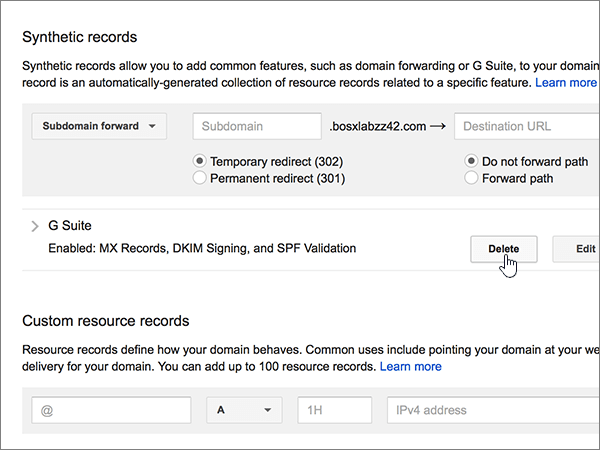
Next, choose Delete.
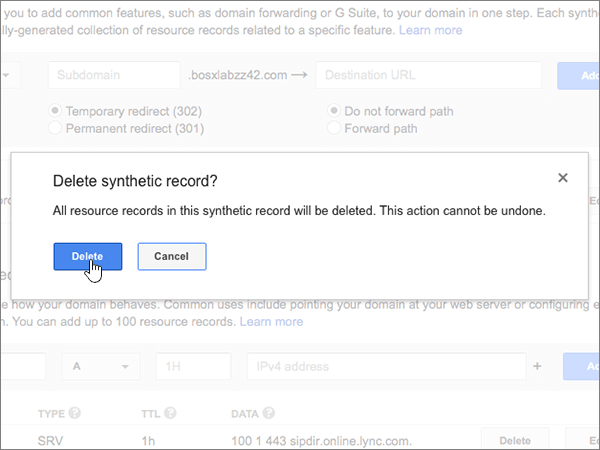
-
In the Custom resource records section, in the boxes for the new record, type or copy and paste the values from the following table.
(You may have to scroll down.)
(Choose the Type value from the drop-down list.)
Name
Type
TTL
Data
@
MX
1H
0 <domain-key>.mail.protection.outlook.com.
This value MUST end with a period (.)
The 0 is the MX priority value. Add it to the beginning of the MX value, separated from the remainder of the value by a space.
Note: Get your <domain-key> from your Office 365 portal account.
How do I find this?For more information about priority, see What is MX priority?
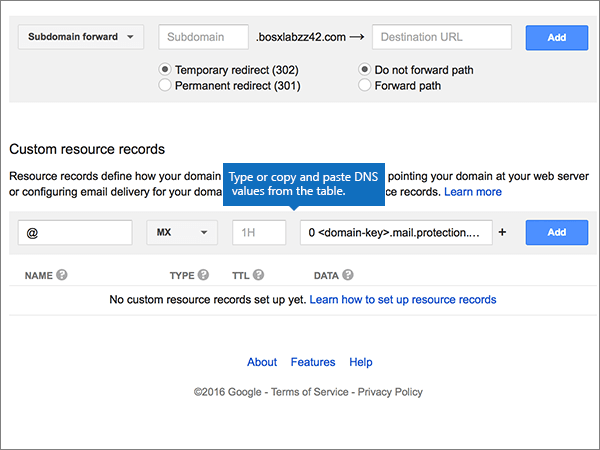
-
Choose Add.
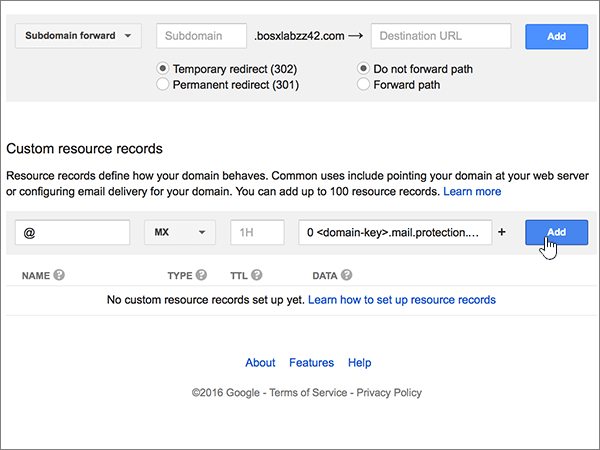
-
If there are any other Custom MX records, remove them.
First, choose Edit in the MX record row.
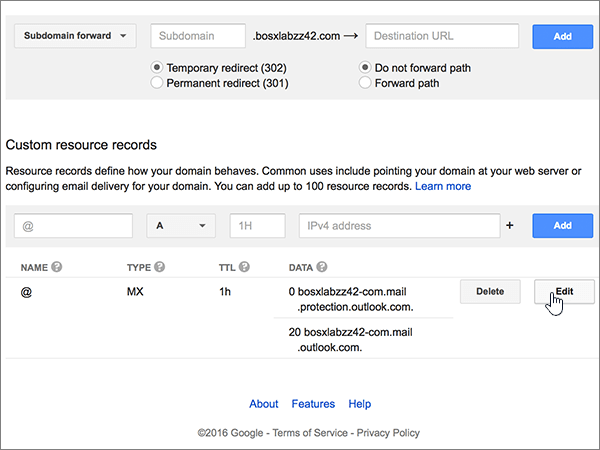
Now, for each of the other Custom MX records, select the entry in the Data box and then press the Delete key on your keyboard to delete that record.
Continue until you have deleted the Data entry for each of the other MX records.
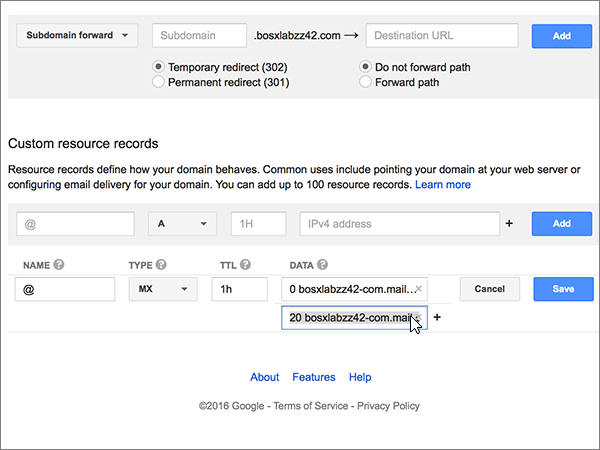
-
When you have deleted the Data entry for each of the other MX records, choose Save to save your changes.
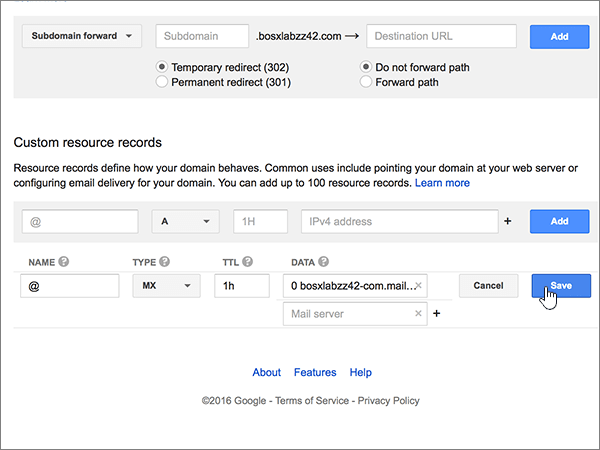
Add the four CNAME records that are required for Office 365
-
To get started, go to your domains page at Google Domains by using this link. You'll be prompted to sign in. To do so:
First, choose Sign In.

Next, enter your login credentials, and then again choose Sign In.

-
On the Domains page, in the Domain section, choose Configure DNS for the domain that you want to edit.

-
Add the first CNAME record.
In the Custom resource records section, in the boxes for the new record, type or copy and paste the values from first row of the following table.
(You may have to scroll down.)
(Choose the Type value from the drop-down list.)
Name
Type
TTL
Data
autodiscover
CNAME
1H
autodiscover.outlook.com.
This value MUST end with a period (.)
sip
CNAME
1H
sipdir.online.lync.com.
This value MUST end with a period (.)
lyncdiscover
CNAME
1H
webdir.online.lync.com.
This value MUST end with a period (.)
msoid
CNAME
1H
clientconfig.microsoftonline-p.net.
This value MUST end with a period (.)
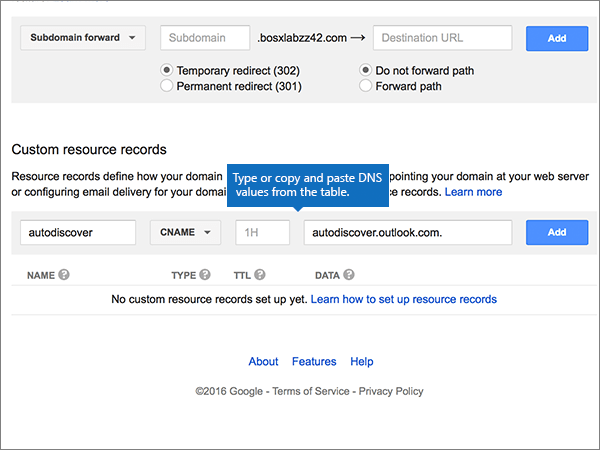
-
Choose Add.
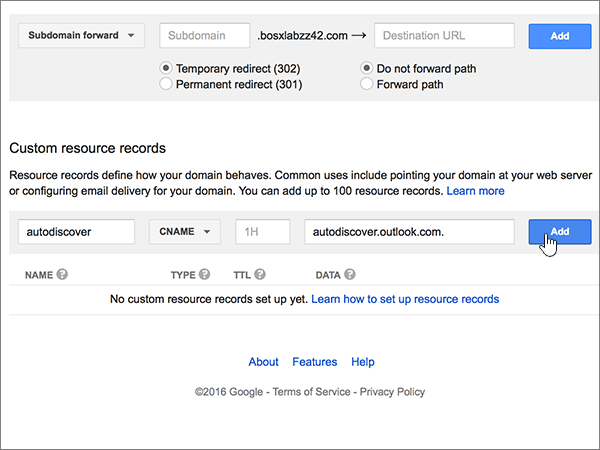
-
Add the other three CNAME records.
In the Custom resource records section, create a record by using the values from the next row in the table, and then again choose Add to complete that record.
Repeat this process until you have created all four CNAME records.
-
Important: If you have Mobile Device Management (MDM) for Office 365, then you must create two additional CNAME records. Follow the procedure that you used for the other four CNAME records, but supply the values from the following table.
(If you do not have MDM, you can skip this step.)
Name
Type
TTL
Data
enterpriseregistration
CNAME
1H
enterpriseregistration.windows.net.
This value MUST end with a period (.)
enterpriseenrollment
CNAME
1H
enterpriseenrollment.manage.microsoft.com.
This value MUST end with a period (.)
Add a TXT record for SPF to help prevent email spam
Important: You cannot have more than one TXT record for SPF for a domain. If your domain has more than one SPF record, you'll get email errors, as well as delivery and spam classification issues. If you already have an SPF record for your domain, don't create a new one for Office 365. Instead, add the required Office 365 values to the current record so that you have a single SPF record that includes both sets of values. Need examples? Check out these details and sample SPF records. To validate your SPF record, you can use one of these SPF validation tools.
-
To get started, go to your domains page at Google Domains by using this link. You'll be prompted to sign in. To do so:
First, choose Sign In.

Next, enter your login credentials, and then again choose Sign In.

-
On the Domains page, in the Domain section, choose Configure DNS for the domain that you want to edit.

-
In the Custom resource records section, on the TXT record row, choose Edit .
Important: Google Domains stores TXT records as a set that may contain multiple records. When you have at least one other TXT record, such as the TXT record you used to verify your domain, you must add TXT new records to that record set. Any attempt to enter additional TXT records as separate entries will result in a Duplicate record error message.
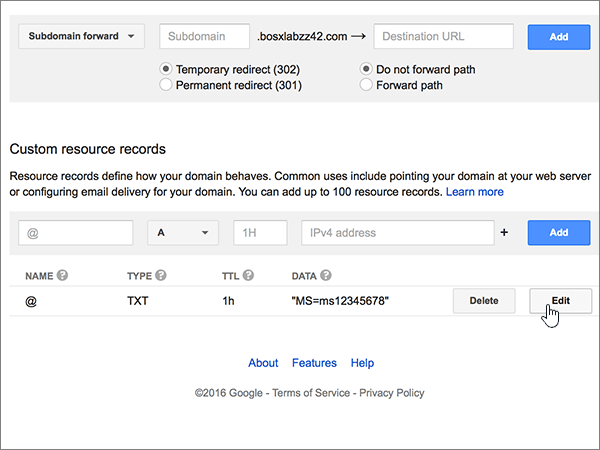
-
Choose the (+) control.
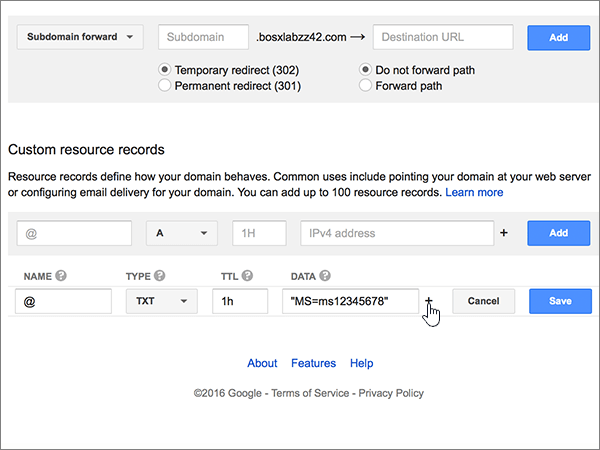
-
In the boxes for the new record, type or copy and paste the values from the following table.
(You may have to scroll down.)
Data
v=spf1 include:spf.protection.outlook.com -all
Note: We recommend copying and pasting this entry, so that all of the spacing stays correct.
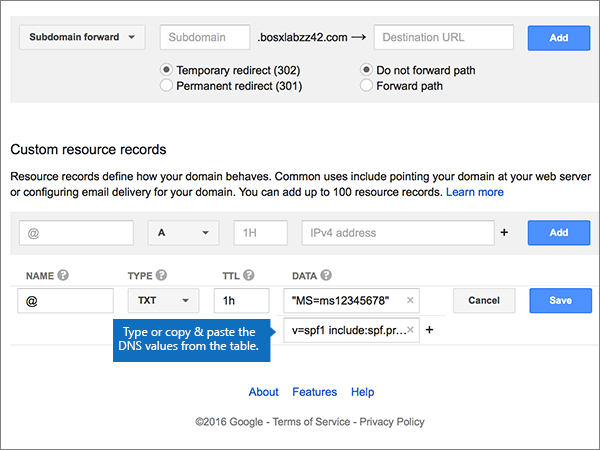
-
Choose Save.
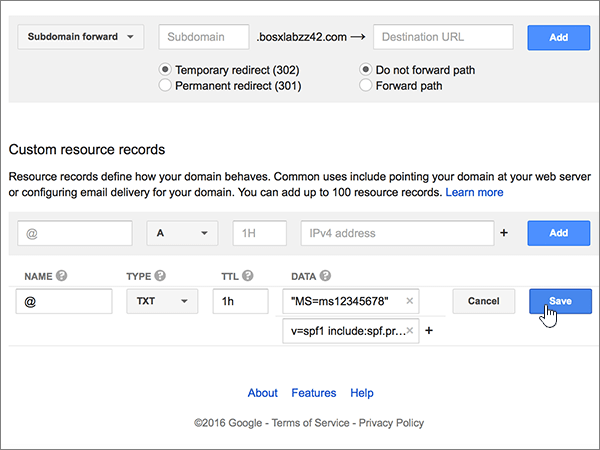
Add the two SRV records that are required for Office 365
-
To get started, go to your domains page at Google Domains by using this link. You'll be prompted to sign in. To do so:
First, choose Sign In.

Next, enter your login credentials, and then again choose Sign In.

-
On the Domains page, in the Domain section, choose Configure DNS for the domain that you want to edit.

-
Add the first SRV record.
In the Custom resource records section, in the boxes for the new record, type or copy and paste the values from the following table.
(You may have to scroll down.)
(Choose the Type value from the drop-down list.)
Name
Type
TTL
Data
_sip._tls
SRV
1H
100 1 443 sipdir.online.lync.com.
This value MUST end with a period (.)
Note: We recommend copying and pasting this entry, so that all of the spacing stays correct.
_sipfederationtls._tcp
SRV
1H
100 1 5061 sipfed.online.lync.com.
This value MUST end with a period (.)
Note: We recommend copying and pasting this entry, so that all of the spacing stays correct.
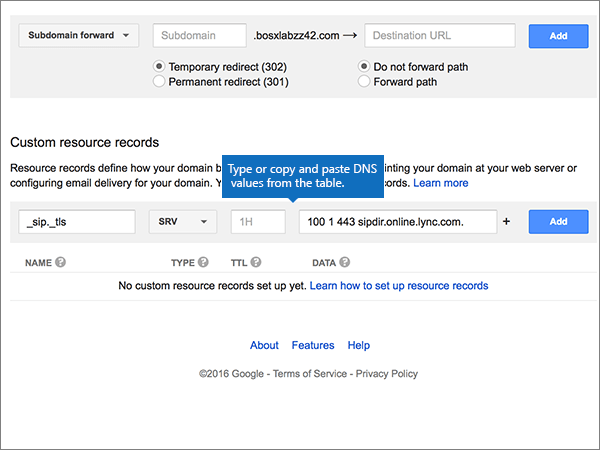
-
Choose Add.
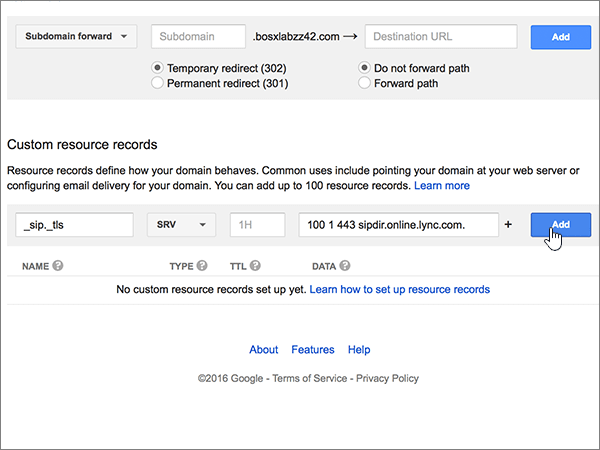
-
Add the other SRV record.
In the Custom resource records section, create a record by using the values from the second row in the table, and then again choose Add to complete that record.
Note: Typically it takes about 15 minutes for DNS changes to take effect. However, it can occasionally take longer for a change you've made to update across the Internet's DNS system. If you're having trouble with mail flow or other issues after adding DNS records, see Troubleshoot issues after changing your domain name or DNS records.
Still need help?



A DNS 'mail exchange' (MX) record guides email to a mail laborer. The MX record indicates how email messages should
ReplyDeletebe coordinated by the Simple Mail Transfer Protocol (SMTP, the standard show for all emails).
Like CNAME records, an MX record ought to always point to another domain.
If you want to know that What Type Of Information Is Contained In A Dns Mx Record then visit this sit for more information:
What Type Of Information Is Contained In A Dns Mx Record?
Microsoft Office Tutorials: Create Dns Records At Google Domains For Office 365 >>>>> Download Now
Delete>>>>> Download Full
Microsoft Office Tutorials: Create Dns Records At Google Domains For Office 365 >>>>> Download LINK
>>>>> Download Now
Microsoft Office Tutorials: Create Dns Records At Google Domains For Office 365 >>>>> Download Full
>>>>> Download LINK Rc
I loved your post.Much thanks again. Fantastic.
ReplyDeleteoracle sql plsql training
go langaunage training
azure training
java training
salesforce training
It is very informative post. Thanks for sharing...
ReplyDeleteGestion des accès
Meilleur logiciel antivirus Ransomware
Microsoft Office Tutorials: Create Dns Records At Google Domains For Office 365 >>>>> Download Now
ReplyDelete>>>>> Download Full
Microsoft Office Tutorials: Create Dns Records At Google Domains For Office 365 >>>>> Download LINK
>>>>> Download Now
Microsoft Office Tutorials: Create Dns Records At Google Domains For Office 365 >>>>> Download Full
>>>>> Download LINK Fq